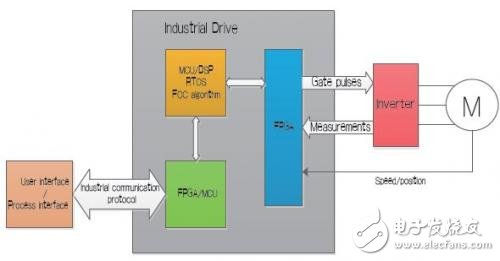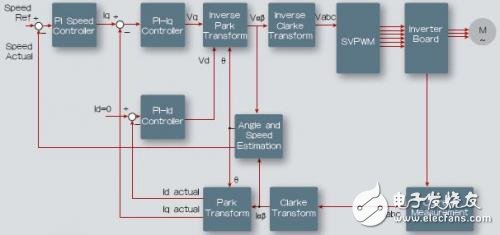There are several factors to consider when selecting a device in an industrial system, including: performance, cost of engineering changes, time to market, personnel skills, the possibility of reusing existing IP/libraries, the cost of field upgrades, and low power consumption. low cost.
Recent developments in the industrial market have driven the need for highly integrated, high performance, low power FPGA devices. Designers prefer network communications rather than peer-to-peer communications, which means additional controllers may be required for communication, which indirectly increases BOM cost, board size, and associated NRE (one-time engineering cost) costs.
Total cost of ownership is used to analyze and estimate the life cycle cost of the acquisition. It is an extended set of all design-related direct and indirect costs, including engineering cost, installation and maintenance costs, bill of materials (BOM) costs, and NRE (R&D) Cost, etc. By considering system-level factors, it is possible to minimize total cost of ownership, resulting in sustainable long-term profitability.
Microsemi offers SmartFusion2 SoC FPGA devices with hard-core ARM Cortex-M3 microcontrollers and IP integration in a cost-optimized package with features that reduce BOM and board size. With low power consumption and a wide temperature range, these devices operate reliably in extreme conditions without a cooling fan. The SmartFusion2 SoC FPGA architecture integrates a hard-core ARM Cortex-M3 IP with the FPGA fabric for greater design flexibility and faster time-to-market. Microsemi offers an ecosystem of multiple multi-axis motor control reference designs and IP for motor control algorithm development, making it easier to move from multi-processor solutions to single-device solutions (ie SoC FPGAs).
Factors affecting TCO
The following are some of the factors that affect the system TCO.
(1) Long life cycle. FPGAs can be reprogrammed after deployment in the field, which extends the life cycle of the product, allowing designers to focus on new product development and achieve faster time to market.
(2) BOM. Microsemi's flash-based FPGAs do not require a startup PROM or flash MCU to load the FPGA at power-up. They are zero-level nonvolatile/instant-on devices. Unlike SRAM-based FPGA devices, Microsemi's flash-based FPGAs do not require an additional power-up monitor because flash switches do not change with voltage.
(3) Time to market. Intense competition among OEMs urgently requires more product differentiation and faster time to market. Proven IP modules dramatically reduce design time. It is now possible to provide multiple IP modules for building industrial solutions, while more modules are under development. Another unique advantage that SoC demonstrates is that it can be used to debug FPGA designs. To debug the FPGA design, the microcontroller subsystem can be used to extract information from the FPGA through a high-speed interface for debugging.
(4) Engineering tool costs. Contrary to the expensive concept of FPGA development tools, Microsemi offers a free Libero SoC IDE for FPGA development that only pays when developing high-end devices.
Industrial drive system
The industrial drive system consists of a motor control device that contains the logic and protection logic that drives the inverter, and a communication device that enables the supervisory control to initialize and modify the runtime parameters.

Figure 1: Typical industrial drive system.
In a typical drive system (Figure 1), multiple controller devices may be used to implement the drive logic. One device may perform calculations related to motor control algorithms, the second device may run communication-related tasks, and the third device may perform safety-related tasks.
Multi-axis motor control
Traditionally, industrial motor control applications use microcontrollers or DSPs to run the complex algorithms required for motor control. In most traditional industrial drives, FPGAs are used with microcontrollers or DSPs for data acquisition and fast-action protection. . In addition to data acquisition, PWM generation, and protection logic, FPGAs have traditionally not played a major role in implementing motor control algorithms.
The method of implementing a motor control algorithm using a microcontroller or DSP is not easily extended to multiple motors operating at independent speeds (multi-axis motor control). The Microsemitech SmartFusion2 SoC FPGA can be integrated and complete with multiple devices using a single device. Motor drive control (Figure 2).

Figure 2: The Microsemitech SmartFusion2 SoC FPGA uses a single device for complete multi-axis motor drive control.
Control can be divided into two parts. One part is used to run field oriented control (FOC) algorithms, speed control, current control, speed estimation, position estimation, and PWM generation; the other part includes speed profiles, load characteristics, process control, and protection (faults and alarms). The implementation of the FOC algorithm is time critical and needs to be performed at very high sampling rates (in the microsecond range), especially for high speed motors with low stator inductance. This makes it more advantageous to implement FOC algorithms in FPGAs. Process control, speed profiles, and other protections do not require fast updates, so they can be executed at lower sample rates (in the millisecond range) and can be programmed in the built-in Cortex-M3 subsystem.
The transistor switching period plays an important role in the drive. If the FOC loop execution time is much shorter than the switching period, the hardware module can be reused to calculate the voltage of the second motor. This means that the device can deliver higher performance at the same cost.

Figure 3: Field Oriented Control (FOC) block diagram of a permanent magnet synchronous motor.
(1) Motor control IP module. Figure 3 shows the sensorless field oriented control algorithm, which is discussed in this section and is provided as an IP core.
◠PI controller. A proportional-integral (PI) controller is a feedback mechanism for controlling system parameters. It has two adjustable gain parameters—proportional and integral gain constants—that control the dynamic response of the controller. The proportional component of the PI controller is the product of the proportional gain constant and the error input, and the integral component is the product of the cumulative error and the integral gain constant. These two components are added together. The integration phase of the PI controller may cause instability in the system because the data values ​​increase uncontrollably. This uncontrolled rise in data is called integral saturation, and all PI controller implementations include an anti-frozen mechanism to ensure that the controller output is limited. Microsemi's PI controller IP module uses a hold-on-saturation algorithm for anti-shaking. This module also provides additional features to set the initial output value.
• Field Oriented Control (FOC). The FOC is an algorithm that provides optimal current to the motor by independently determining and controlling the torque and magnetization current components. In a permanent magnet synchronous motor (PMSM), the rotor has been magnetized. Therefore, the current supplied to the motor is only used for torque. FOC is a computationally intensive algorithm, but the Microsemi's motor control reference design has been built for optimal use of device resources. The FOC algorithm includes Clarke, Park, inverse Clarke, and inverse Park transform.
◠Angle estimation. One input to the FOC is the rotor angle. Accurate determination of the rotor angle is essential to ensure low power consumption. Adding physical sensors that determine position and speed increases system cost and reliability. Sensorless algorithms help eliminate sensors but increase computational complexity. Microsemi offers two angle calculation algorithm IP modules for sensorless control—one based on the Luenberger observer and the other based on direct back EMF calculations. The company also offers a separate reference design based on Hall sensors and encoders.
• PLL.PLL is used to synchronize signals and is useful in many applications, such as angle estimation of the inverter and grid synchronization.
â— Rate limiter. The rate limiter module can implement smooth changes to system variables or inputs. For example, in a motor control system, if the speed required by the motor suddenly changes, the system may become unstable. To avoid such situations, the rate limiter module is used to transition from the initial speed to the desired speed. The rate limiter module can be configured to control the rate of change.
â— Space vector modulation. The space vector modulation module improves DC bus utilization and eliminates short pulses from transistor switches. Because the transistor turn-on/turn-off time is longer than the pulse duration, short pulses can cause incorrect switching behavior.
â— Three-phase PWM generation. At the end of all calculations, a three-phase motor voltage is available. These voltages are used to generate the switching signals of the transistors in the inverter. The PWM module generates switching signals for six (three high-side and three low-side) transistors with advanced features such as dead time and delay time insertion. The programmable dead time insertion feature helps to avoid catastrophic short circuits on the inverter pins. The programmable delay time insertion feature allows ADC measurements to be synchronized with PWM signal generation. The module can be configured to operate with an inverter consisting only of N-MOSFETs or an inverter comprising both N-MOSFETs and P-MOSFETs.
(2) Debug the FPGA design in the SoC. In general, debugging a design on a microcontroller is relatively simpler than debugging on an FPGA. In SoCs, you can take advantage of the high performance of FPGAs while maintaining the advantages of faster debugging in microcontrollers. The microcontroller subsystem and FPGA architecture in the Microsemitech SmartFusion2 SoC FPGA can communicate with each other via the AMBA APB or AXI bus. This allows test data to be injected into the FPGA fabric or debug data from the FPGA fabric to help visualize internal data for runtime and for real-time debugging. The firmware code can be run in a single step, and breakpoints can be set in the code to analyze the FPGA register data.
Kitchen Range Hood Motor,Range Hood Motor,Kitchen Range Hood,Range Hood Fan Motor
WUJIANG JINLONG ELECTRIC APPLIANCE CO., LTD , https://www.jinlongmotor.com